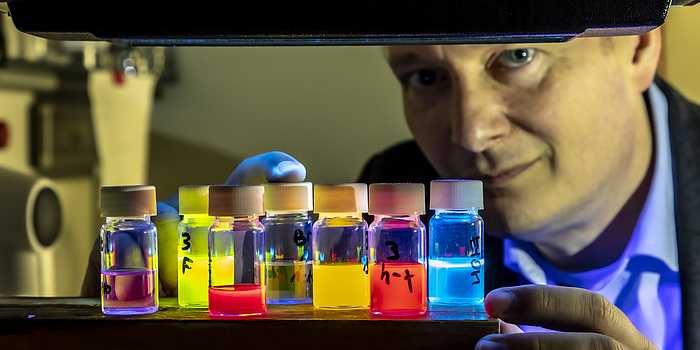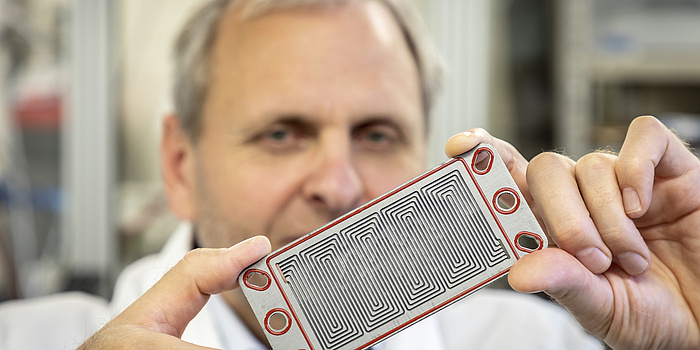Increasingly extreme weather events, such as torrential rain, hurricanes, droughts and intense snowfalls, clearly show that our world is in the midst of a climate crisis. The reason for this is the greenhouse effect. Greenhouse gases such as CO2 are released into the atmosphere, where they absorb light energy and thus warm the earth from within. And even though it is almost like closing the stable door after the horse has bolted in terms of climate protection, as researcher Martin Wilkening puts it, he and other scientists at Graz University of Technology (TU Graz) are working intensively on new measures to achieve the climate goals.
Mobility
Whether hydrogen, electricity or a completely different energy carrier is the future of mobility, there are already many possible solutions being worked on at TU Graz.
For Wilkening, head of the Institute of Chemistry and Technology of Materials, electricity in combination with efficient battery storage is clearly the means of choice. "We need implimentable possibilities – because we've slept through climate change. The electricity grid already exists and we've had many functioning battery storage systems in use for a long time. We should take advantage of that." In addition, a battery with an efficiency of 90 per cent is still the most efficient of all energy storage systems currently under discussion. Along with his team, Wilkening is conducting research on the fundamentals of batteries – on efficient materials. "We're asking ourselves the very simple questions. Such as, why is one material better suited to conducting ions than another? It's with the answers to these questions that it gets interesting." Basically, a solid-state battery charges and discharges as particles bounce back and forth in an ion-conducting crystal structure, enabling charge transport. Depending on the temperature, these atomic movements are faster or slower. "We are investigating precisely this diffuse movement with spectroscopic methods, such as nuclear magnetic resonance. It tells us how many place changes there are in a given unit of time. And we are studying what happens when we modify the material."
We're asking ourselves the very simple questions. And then it gets interesting.

Gregor Trimmel. © Lunghammer – TU Graz
Together with institute colleague Gregor Trimmel, Wilkening is working on a combination of battery storage and organic solar cells. Organic solar cells can be applied in extremely thin layers, are flexible to roll and easy to print. Because of their flexibility, they are particularly suitable for balcony shades and blinds, for example. "Organic solar cells are currently only slightly less effective than their inorganic counterparts," explains Trimmel. "But especially indoors and in other areas with little sunlight, our organic materials have a particularly good energy yield." So they could also be used, for example, to extend the life of batteries in household appliances.
Viktor Hacker, head of the Fuel Cell and Hydrogen Systems working group at the Institute of Chemical Engineering and Environmental Technology, on the other hand, is convinced of hydrogen as an energy carrier. His speciality is low-temperature fuel cells, which, unlike high-temperature fuel cells, can already be operated at room temperature. They use high-purity hydrogen produced from renewable energy sources and release energy again. "The great advantage of hydrogen is its long range and short refuelling times. Once the necessary infrastructure has been set up, a hydrogen vehicle hardly differs from current combustion engine vehicles in terms of handling," says Hacker. "At the moment, the main argument against hydrogen is the price – it is very expensive. But that will also change in the medium to long term." Above all, he said, support is now needed from the political and economic sides to bring hydrogen into the breadth of our transport system.

Viktor Hacker. © Lunghammer – TU Graz
Hydrogen as an energy carrier of the future was the topic of the TU Graz research magazine in its 2020 winter issue. Read the article on research at TU Graz in the e-paper.
Helmut Eichlseder, on the other hand, pleads for an approach that is open to technology in order to shape the mobility of the future. "For example, electrically powered vehicles (EVs) are wonderful for inner cities. But they reach their limits in heavy and marine transport. Hydrogen is much more suitable in this area," explains the head of the Institute of Internal Combustion Engines and Thermodynamics and adds: "I believe that not one solution should be dogmatically pushed, but each should be implemented in the environment that suits it." In addition to these new forms of propulsion, he sees great potential in e-fuels. "Even when we approve the last internal combustion engine vehicles for use on the roads in a few years, they will still be driving around for decades. E-fuels are a simple and effective way to make the existing fleet more environmentally friendly in a backward-compatible way." E-fuels are fuels produced by means of renewable energy through electrolysis followed by synthesis with CO2 – making them independent of fossil fuels. The great advantage of e-fuels is that they can be used in conventional combustion engines and distributed via the existing filling station infrastructure.
Helmut Eichlseder explains in a Planet Research article why the combustion engine is still important – even in a sustainable mobility mix.
Construction
The construction industry is a resource-intensive sector that contributes significantly to global CO2 emissions. In the European Union, for example, buildings are responsible for up to 36% of CO2 emissions. So it is immensely important to become more environmentally friendly in this area as well.
With the Centre for Sustainable Construction, which is currently being established, TU Graz will set a new accent in the future. With the subtitle "for a climate-neutral built environment", the centre is dedicated to the man-made, built environment of the future. "The built environment includes all kinds of structures and infrastructures – from buildings where we live and work, to roads and railways, to infrastructures and the supply of energy and water. Accordingly, the topics addressed at the centre are complex, ranging from urban planning issues to research activities in the field of building materials," explains Michael Monsberger, researcher at the Institute of Building Physics, Services, and Construction. As part of a team of over 30 scientists at TU Graz, he is currently working on a development plan for the centre. Monsberger explains further that, particularly in Europe, for example, the topic of existing buildings is also a very important one. Through appropriate renovation measures, existing buildings can and must also be made climate-ready.
"It's an extremely exciting time right now. Due to the urgent need for action in the area of climate protection and new technological possibilities due to advancing digitalization, we are experiencing a transformation in the construction sector and can help shape it as researchers." Helping to shape it counts as one of the most important topics for him. "In this context, it is also important to transfer developed solution concepts from research into practice – how do we manage to get our ideas taken up quickly? This aspect will also be addressed in the centre in the future."
It's an extremely exciting time right now.
This video is hosted by Youtube, clicking on it will send data to Youtube. The privacy policy of Youtube applies.
Play video
Play video
The TU Graz Science for Future Science Day also dealt with the topics of climate and energy this year - check it out here.
Energy supply
Sonja Wogrin, head of the Institute of Electricity Economics and Energy Innovation, is looking at our energy supply. She and her team simulate electricity systems, evaluate them, look for optimization potential and test innovations in "dry operation". "There are very many technical and economic challenges that have not yet been solved in current electricity systems and in today's markets," says the researcher. And policy issues are also extremely relevant: "There is still an unanswered question regarding climate neutrality: who will bear the infrastructure costs when energy sources like the sun or the wind are available virtually for free?"
There is still an unanswered question regarding climate neutrality: who will bear the infrastructure costs when energy sources like the sun or the wind are available virtually for free?
Climate-neutral TU Graz
TU Graz has set itself the goal of working and conducting research in a climate-neutral manner by 2030. Based on a comprehensive greenhouse gas balance, the newly founded Sustainability Advisory Board of TU Graz has developed a roadmap that defines the path to be taken towards climate neutrality. Specifically, the focus is on changes in mobility management, and corrections in energy management in terms of business trips and new buildings. In future, unavoidable greenhouse gas emissions will be compensated with a subsidy, which in turn will benefit climate protection research projects.
All information on the comprehensive Climate-Neutral TU Graz project can be found online at the project website.
This research area is anchored in the Field of Expertise “Sustainable Systems”, one of five strategic foci of TU Graz.
You can find more research news on Planet research. Monthly updates from the world of science at Graz University of Technology are available via the research newsletter TU Graz research monthly.

